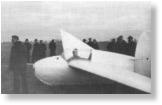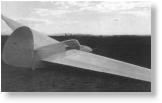|
AV-17
| |
  |
| The AV-17 |
| (click
on the picture to enlarge it in a new window) |
As a result of his experience with the AV-3, Charles Fauvel began to think
about a new improved prototype. World War II didn't
immediately allow him to realize his objective, but once
the conflict was over, he resumed his quest at the
Société Aéronautique du Rhône, near
Bourg-lès-Valence with his newest prototype, the AV-17.
The aircraft was destroyed in its first flights.
According to Charles Fauvel, the glider had not been
constructed correctly; as the cause of the accident was
neither the fault of the pilot nor did it discourage
Fauvel in pursuit of his flying wing design formula.
Fauvel, having raised serious doubts about the AV-17's
construction, was convinced that the blame for the crash
should be placed upon the Société Aéronautique du
Rhône, the constructor. Although the AV-17 never flew
again, the experience gained was a great contribution to
the development of later designs by Charles Fauvel.
| Characteristics
and performance of the AV-17 |
| Wing span |
15.00
m |
| Length |
4.75
m |
| Wing area |
17.30
m2 |
| Airfoil |
Fauvel
|
| Aspect ratio |
13.00 |
| Empty weight |
195
kg |
| Glide ratio |
27:1 |
| Sink rate |
0.60
m/sec |
|

